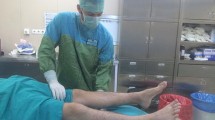Abstract
Purpose
We evaluated the correlation between physical examinations and the tear patterns of the anterior cruciate ligament (ACL).
Materials and methods
From January 2003 to May 2007, we reviewed 201 cases of ACL rupture, diagnosed by MRI. Two orthopaedic surgeons (a fellow and a senior surgeon) evaluated the instability of the knee under anaesthesia: physical examinations were the anterior draw test (AD), Lachman test (LT), and pivot shift test (PT). By describing the rupture pattern and the site of the anteromedial (AMB) and posterolateral bundle (PLB) during arthroscopic examination, we analysed the correlation between the physical examination under anaesthesia and arthroscopic findings.
Results
In terms of the arthroscopic findings, rupture of the PLB was seen in 83 cases (41.3 %), of the AMB in 24 cases (11.9 %), and of both bundles in 94 cases (46.8 %). The kappa values for the physical examinations between the examiners were 0.963 (AD), 0.92 (LT), and 0.865 (PT). AD and LT above grade 2 did not differ significantly according to the pattern of rupture, but a PT above grade 2 was significantly different in ruptured PLB versus complete rupture.
Conclusions
A PT of more than grade 2 is a reliable physical examination for prediction of ruptured PLB or complete rupture.





Similar content being viewed by others
References
Petersen W, Tillmann B (2002) Anatomy and function of the anterior cruciate ligament. Orthopade 31(8):710–718
Yasuda K, Kondo E, Ichiyama H, Kitamura N, Tanabe Y, Tohyama H, Minami A (2004) Anatomic reconstruction of the anteromedial and posterolateral bundles of the anterior cruciate ligament using hamstring tendon grafts. Arthroscopy 20(10):1015–1025. doi:10.1016/j.arthro.2004.08.010
Woo SL, Kanamori A, Zeminski J, Yagi M, Papageorgiou C, Fu FH (2002) The effectiveness of reconstruction of the anterior cruciate ligament with hamstrings and patellar tendon. A cadaveric study comparing anterior tibial and rotational loads. J Bone Joint Surg Am 84-A(6):907–914
Amis AA, Dawkins GP (1991) Functional anatomy of the anterior cruciate ligament. Fibre bundle actions related to ligament replacements and injuries. J Bone Joint Surg Br 73(2):260–267
Yoon KH, Bae DK, Cho SM, Park SY, Lee JH (2009) Standard anterior cruciate ligament reconstruction versus isolated single-bundle augmentation with hamstring autograft. Arthroscopy 25(11):1265–1274. doi:10.1016/j.arthro.2009.05.020
Siebold R, Fu FH (2008) Assessment and augmentation of symptomatic anteromedial or posterolateral bundle tears of the anterior cruciate ligament. Arthroscopy 24(11):1289–1298. doi:10.1016/j.arthro.2008.06.016
Mitsou A, Vallianatos P (1988) Clinical diagnosis of ruptures of the anterior cruciate ligament: a comparison between the Lachman test and the anterior drawer sign. Injury 19(6):427–428
Donaldson WF 3rd, Warren RF, Wickiewicz T (1985) A comparison of acute anterior cruciate ligament examinations. Initial versus examination under anesthesia. Am J Sports Med 13(1):5–10
Katz JW, Fingeroth RJ (1986) The diagnostic accuracy of ruptures of the anterior cruciate ligament comparing the Lachman test, the anterior drawer sign, and the pivot shift test in acute and chronic knee injuries. Am J Sports Med 14(1):88–91
Kocher MS, Micheli LJ, Zurakowski D, Luke A (2002) Partial tears of the anterior cruciate ligament in children and adolescents. Am J Sports Med 30(5):697–703
Lubowitz JH, Bernardini BJ, Reid JB 3rd (2008) Current concepts review: comprehensive physical examination for instability of the knee. Am J Sports Med 36(3):577–594. doi:10.1177/0363546507312641
Bull AMJ, Amis AA (1998) The pivot-shift phenomenon: a clinical and biomechanical perspective. Knee 5(3):141–158. doi:10.1016/S0968-0160(97)10027-8
DeFranco MJ, Bach BR Jr (2009) A comprehensive review of partial anterior cruciate ligament tears. J Bone Joint Surg Am 91(1):198–208. doi:10.2106/JBJS.H.00819
Hole RL, Lintner DM, Kamaric E, Moseley JB (1996) Increased tibial translation after partial sectioning of the anterior cruciate ligament. The posterolateral bundle. Am J Sports Med 24(4):556–560
Zantop T, Wellmann M, Fu FH, Petersen W (2008) Tunnel positioning of anteromedial and posterolateral bundles in anatomic anterior cruciate ligament reconstruction: anatomic and radiographic findings. Am J Sports Med 36(1):65–72. doi:10.1177/0363546507308361
Furman W, Marshall JL, Girgis FG (1976) The anterior cruciate ligament. A functional analysis based on postmortem studies. J Bone Joint Surg Am 58(2):179–185
Ochi M, Adachi N, Deie M, Kanaya A (2006) Anterior cruciate ligament augmentation procedure with a 1-incision technique: anteromedial bundle or posterolateral bundle reconstruction. Arthroscopy 22(4):e461–e465
Adachi N, Ochi M, Uchio Y, Sumen Y (2000) Anterior cruciate ligament augmentation under arthroscopy. A minimum 2-year follow-up in 40 patients. Arch Orthop Trauma Surg 120(3–4):128–133
Adachi N, Ochi M, Uchio Y, Iwasa J, Ryoke K, Kuriwaka M (2002) Mechanoreceptors in the anterior cruciate ligament contribute to the joint position sense. Acta Orthop Scand 73(3):330–334. doi:10.1080/000164702320155356
Lintner DM, Kamaric E, Moseley JB, Noble PC (1995) Partial tears of the anterior cruciate ligament. Are they clinically detectable? Am J Sports Med 23(1):111–118
Zantop T, Herbort M, Raschke MJ, Fu FH, Petersen W (2007) The role of the anteromedial and posterolateral bundles of the anterior cruciate ligament in anterior tibial translation and internal rotation. Am J Sports Med 35(2):223–227. doi:10.1177/0363546506294571
Kondo E, Merican AM, Yasuda K, Amis AA (2014) Biomechanical analysis of knee laxity with isolated anteromedial or posterolateral bundle-deficient anterior cruciate ligament. Arthroscopy 30(3):335–343. doi:10.1016/j.arthro.2013.12.003
Niitsu M, Kuramochi M, Ikeda K, Fukubayashi T, Anno I, Itai Y (1995) MR imaging features of chronically torn anterior cruciate ligament. Nihon Igaku Hoshasen Gakkai zasshi Nippon acta radiologica 55(7):477–482
Higueras Guerrero V, Torregrosa Andres A, Marti-Bonmati L, Casillas C, Sanfeliu M (1999) Synovialisation of the torn anterior cruciate ligament of the knee: comparison between magnetic resonance and arthroscopy. Eur Radiol 9(9):1796–1799 90091796.330 [pii]
Matthews P, Richards H (1976) Factors in the adherence of flexor tendon after repair: an experimental study in the rabbit. J Bone Joint Surg Br 58(2):230–236
Conflict of interest
The authors have declared that they have no conflict of interest.
Author information
Authors and Affiliations
Corresponding author
Rights and permissions
About this article
Cite this article
Yoon, K.H., Lee, S.H., Park, S.Y. et al. Can physical examination predict the intraarticular tear pattern of the anterior cruciate ligament?. Arch Orthop Trauma Surg 134, 1451–1457 (2014). https://doi.org/10.1007/s00402-014-2048-y
Received:
Published:
Issue Date:
DOI: https://doi.org/10.1007/s00402-014-2048-y




